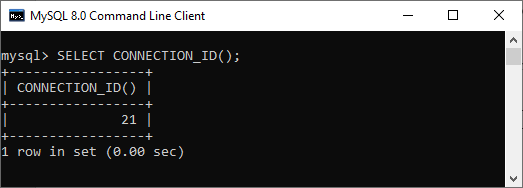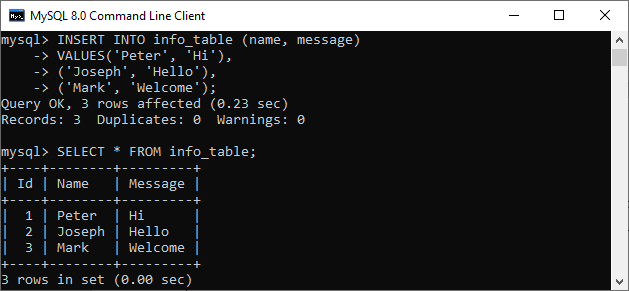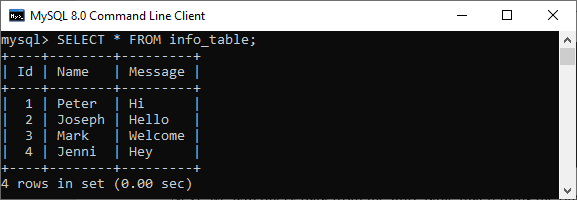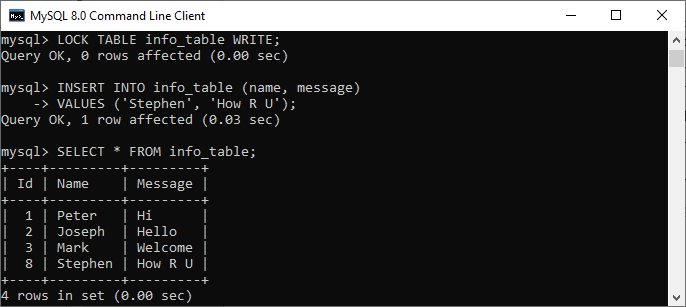-
MySQL Tutorial
- mysql-tutorial
- mysql-features
- mysql-versions
- mysql-data-types
- mysql-variables
- install-mysql
- mysql-connection
MySQL Workbench
User Management
MySQL Database
- mysql-create-database
- mysql-select-database
- mysql-show-databases
- mysql-drop-database
- mysql-copy-database
Table & Views
- mysql-create-table
- mysql-alter-table
- mysql-show-tables
- mysql-rename-table
- mysql-truncate-table
- mysql-describe-table
- mysql-drop-table
- mysql-temporary-table
- mysql-copy-table
- mysql-repair-table
- mysql-add/delete-column
- mysql-show-columns
- mysql-rename-column
- mysql-views
- mysql-table-locking
- mysql-account-lock
MySQL Queries
- mysql-select-record
- mysql-replace
- insert-on-duplicate-key-update
- mysql-insert-ignore
- insert-into-select
MySQL Indexes
- mysql-create-index
- mysql-drop-index
- mysql-show-indexes
- mysql-unique-index
- mysql-clustered-index
- mysql-clustered-vs-non-clustered-index
MySQL Clauses
MySQL Privileges
Control Flow Function
MySQL Conditions
- mysql-and
- mysql-or
- mysql-and-or
- mysql-boolean
- mysql-like
- mysql-in
- mysql-any
- mysql-exists
- mysql-not
- mysql-not-equal
- mysql-is-null
- mysql-is-not-null
- mysql-between
MySQL Join
- mysql-join
- mysql-inner-join
- mysql-left-join
- mysql-right-join
- mysql-cross-join
- mysql-self-join
- mysql-delete-join
- mysql-update-join
- mysql-equijoin
- mysql-natural-join
- left-join-vs-right-join
- mysql-union-vs-join
MySQL Key
MySQL Triggers
- mysql-trigger
- mysql-create-trigger
- mysql-show-trigger
- mysql-drop-trigger
- before-insert-trigger
- after-insert-trigger
- mysql-before-update-trigger
- mysql-after-update-trigger
- mysql-before-delete-trigger
- mysql-after-delete-trigger
Aggregate Functions
- mysql-aggregate-functions
- mysql-count()
- mysql-sum()
- mysql-avg()
- mysql-min()
- mysql-max()
- mysql-group_concat()
- mysql-first()
- mysql-last()
MySQL Misc
- mysql-comments
- export-import-database
- import-csv-file-in-database
- export-table-to-csv
- mysql-subquery
- mysql-derived-table
- mysql-uuid
- lead-and-lag-function
- mysql-cte
- mysql-on-delete-cascade
- mysql-upsert
- mysql-commands-cheat-sheet
- mysql-transaction
- mysql-partitioning
- mysql-row_number()
- mysql-cursor
- mysql-limit
- mysql-stored-function
- mysql-signal-resignal
- number-format-function
- mysql-ranking-functions
- mysql-window-functions
- mysql-union
- union-vs-union-all
- mysql-varchar
- mysql-enum
- mysql-set
- mysql-decimal
- mysql-cast
- mysql-convert()
- mysql-coalesce()
- mysql-wildcards
- mysql-alias
- mysql-functions
- mysql-rollup
- mysql-int
- mysql-today
- mysql-row-count
- prepared-statement
- mysql-literals(constants)
- mysql-date-time
- mysql-procedure
- mysql-minus
- mysql-intersect
- mysql-storage-engines
- mysql-explain
- mysql-sequence
- mysql-json
- mysql-standard-deviation
- how-to-select-nth-highest-record
- find-duplicate-records
- delete-duplicate-records
- mysql-select-random-records
- mysql-extract
- mysql-processlist
- mysql-bit
- change-column-type
- mysql-reset-auto-increment
- mysql-interval
- login-with-different-user
MySQL Globalisation
Regular Expressions
- regular-expressions
- mysql-rlike
- not-like-operator
- not-regexp-operator
- regexp-operator
- regexp_instr()-function
- regexp_like()-function
- regexp_replace()-function
- regexp_substr()-function
FULLTEXT Search
- mysql-fulltext-search
- natural-language-fulltext-search
- boolean-fulltext-search
- query-expansion-fulltext-search
- ngram-fulltext-parser
Differences
- mysql-vs-mongodb
- mysql-vs-ms-sql-server
- mysql-vs-oracle
- mariadb-vs-mysql
- postgresql-vs-mysql
- mysql-vs-sql
- table-vs-view
- delete-vs-truncate-command
- database-vs-schema
- primary-key-vs-foreign-key
- primary-key-vs-unique-key
- primary-key-vs-candidate-key
Interview Questions
MySQL Table LockingA lock is a mechanism associated with a table used to restrict the unauthorized access of the data in a table. MySQL allows a client session to acquire a table lock explicitly to cooperate with other sessions to access the table's data. MySQL also allows table locking to prevent it from unauthorized modification into the same table during a specific period. A session in MySQL can acquire or release locks on the table only for itself. Therefore, one session cannot acquire or release table locks for other sessions. It is to note that we must have a TABLE LOCK and SELECT privileges for table locking. Table Locking in MySQL is mainly used to solve concurrency problems. It will be used while running a transaction, i.e., first read a value from a table (database) and then write it into the table (database). MySQL provides two types of locks onto the table, which are: READ LOCK: This lock allows a user to only read the data from a table. WRITE LOCK: This lock allows a user to do both reading and writing into a table. It is to note that the default storage engine used in MySQL is InnoDB. The InnoDB storage engine does not require table locking manually because MySQL automatically uses row-level locking for InnoDB tables. Therefore, we can do multiple transactions on the same table simultaneously to read and write operations without making each other wait. All other storage engines use table locking in MySQL. Before understanding the table locking concept, first, we will create a new table named "info_table" using the statement as follows: MySQL LOCK TABLES StatementThe following is the syntax that allows us to acquire a table lock explicitly: In the above syntax, we have specified the table name on which we want to acquire a lock after the LOCK TABLES keywords. We can specify the lock type, either READ or WRITE. We can also lock more than one table in MySQL by using a list of comma-separated table's names with lock types. See the below syntax: MySQL UNLOCK TABLES StatementThe following is the syntax that allows us to release a lock for a table in MySQL: LOCK TYPESLet us understand the lock types in detail. READ LocksThe following are the features of the READ lock:
Let us take an example to see how READ locks work in MySQL with the given scenario. We will first connect to the database and use the CONNECTION_ID() function that gives the current connection id in the first session as follows: See the below output:  Next, we will insert few rows into the info_table using the below statement: Now, verify the data into the table using the below statement: We should see the output as follows:  Now, we will execute the LOCK TABLE statement to acquire a lock onto the table: After that, we will try to insert a new record into the info_table as follows: We will get the below output where MySQL issues the following message "Table 'info_table' was locked with a READ lock and can't be updated".  Thus, we can see that once the READ lock is acquired on to the table, we cannot write data to the table in the same session. Now, we will check how the READ lock work from a different session. First, we will connect to the database and see the connection id:  Next, we will query data from the info_table that returns the output as follows:  Then, insert some rows into this table as follows: We should see the output as follows:  In the above output, we can see that the insert operation from the second session is in the waiting state. It is due to the READ lock, which is already acquired on the table by the first session and has not been released yet. We can see the detailed information about them using the SHOW PROCESSLIST statement in the first session. See the below output:  Finally, we need to release the lock by using the UNLOCK TABLES statement in the first session. Now, we are able to execute the INSERT operation in the second session. Write LocksThe following are the features of a WRITE lock:
Let us take an example to see how WRITE locks works in MySQL with the given scenario. In the first session, we will acquire a WRITE lock using the below statement: Then, we will insert a new record into the info_table as follows: The above statement worked. Now, we can verify the output using the SELECT statement:  Again, we will attempt to access (read/write) the table from the second session: We can see that these operations are put into a waiting state. See the detailed information about them using the SHOW PROCESSLIST statement:  Finally, we will release the lock from the first session. Now, we can execute the pending operations. Read vs. Write Lock
Next TopicMySQL Account Lock
|